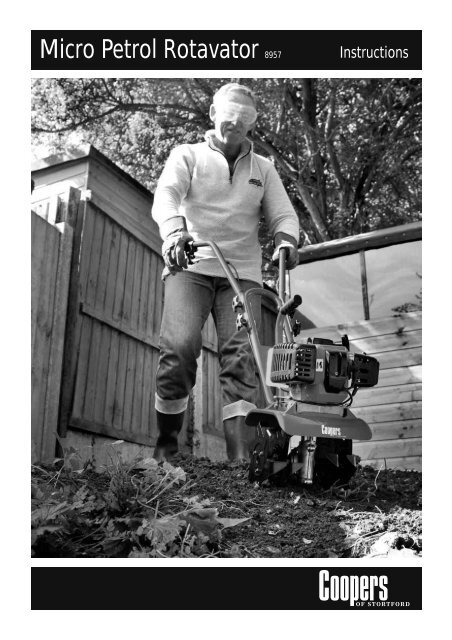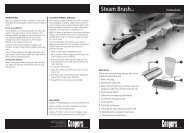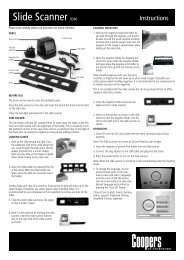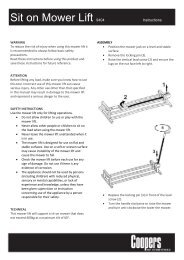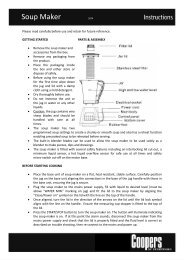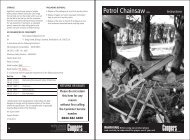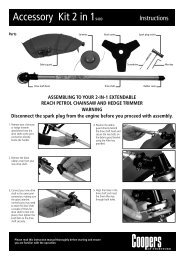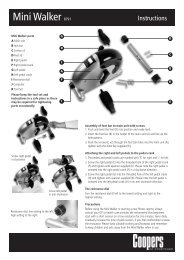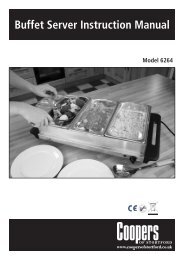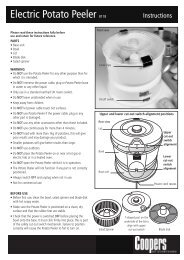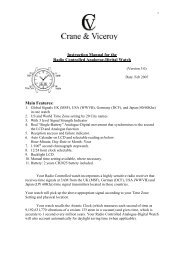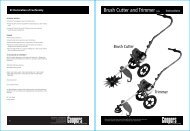Download PDF instructions for The Micro-light Petrol Tiller/Cultivator
Download PDF instructions for The Micro-light Petrol Tiller/Cultivator
Download PDF instructions for The Micro-light Petrol Tiller/Cultivator
You also want an ePaper? Increase the reach of your titles
YUMPU automatically turns print PDFs into web optimized ePapers that Google loves.
<strong>Micro</strong> <strong>Petrol</strong> Rotavator 8957Instructions
INTRODUCTIONCongratulations on your purchase of a new rotavator.We are certain you will be pleased with your purchaseof one of the finest rotavators on the market. It hasbeen designed, engineered and manufactured to giveyou the best possible dependability and per<strong>for</strong>mance.We want to help you get the best results from yourrotavator and to operate it safely. <strong>The</strong>se <strong>instructions</strong>contain the in<strong>for</strong>mation on how to do exactly that.Please read and retain these <strong>instructions</strong> carefully. <strong>The</strong><strong>instructions</strong> will enable you to assemble and maintainyour rotavator properly. Should you experience anyproblems you cannot easily remedy, please contactyour nearest authorised service centre. Always observethe “SAFETY INFORMATION” section. We reserve theright to discontinue or change specifications or designat any time without notice and without incurring anyobligation whatsoever.SAFETY INFORMATION• Read these <strong>instructions</strong> carefully. Be thoroughlyfamiliar with the controls and the proper use of therotavator. Know how to stop and disengage thecontrols quickly.• Never allow children to operate the rotavator. Neverallow adults to operate the rotavator without proper<strong>instructions</strong>.• Keep the area of operation clear of all persons,particularly small children and pets.• Of course, it is not possible or practical to warn youabout all the hazards associated with operating ormaintaining a tiller. You must use your own goodjudgement.• You will find important safety in<strong>for</strong>mation in avariety of <strong>for</strong>ms.• Damage Prevention messages – you will also seeother important messages that are preceded by theword NOTICE.• Safety Labels–on the product.• Instructions–how to use this tiller correctly andsafely.• Safety Messages–preceded by a safety alertsymbol and one of three safety words: DANGER,WARNING and CAUTION.You may be SERIOUSLY HURT ifDANGER you do not follow <strong>instructions</strong>.WARNINGCAUTIONYou may be or SERIOUSLY HURTif you do not follow <strong>instructions</strong>.You CAN be HURT if you do notfollow <strong>instructions</strong>.Your rotavator or other propertyNOTICE can be damaged if you do notfollow <strong>instructions</strong>.Each message tells you what the hazard is,what can and/or may happen, and what youcan do to avoid and/or reduce injury.2
ContentsINTRODUCTION 2SAFETY INFORMATION 2PREPARATION 4OPERATION 4MAINTENANCE 5CUSTOMER RESPONSIBILITIES 5ASSEMBLY 6SAFETY LABEL INFORMATION 7KNOWING YOUR ROTAVATOR 8STOPPING TINES 9STOPPING ENGINE 9TILLING 10DEPTH STAKE 10CULTIVATING 11TINE REMOVAL 11TO TRANSPORT ROTAVATOR 12ADDING PETROL 12STARTING ENGINE 13BREAKING IN YOUR ROTAVATOR 14STORING YOUR ROTAVATOR 14MAINTENANCE 15 – 17SERVICE AND ADJUSTMENTS 18TROUBLE SHOOTING 193
PREPARATION• <strong>The</strong> rotavator tines can throw rocks andother objects with enough <strong>for</strong>ce to causeinjury.• Thoroughly inspect the area where therotavator is going to be used and removeall <strong>for</strong>eign objects.• Disengage all clutches, throttle levers intoneutral be<strong>for</strong>e starting the engine.• Do not operate the rotavator withoutwearing adequate outer garments. Alwayswear eye protection, trousers and adequatefootwear that will improve footing onslippery surfaces.• <strong>The</strong> rotating tines can/will cause injury.Keep away from the tines whenever theengine is running. If you need to adjust thetines or work on the unit <strong>for</strong> any reason,always stop the engine. Disconnect thespark plug cap if you need to clean orhandle the tines.• Handle fuel with extreme care, it is highlyflammable.• Never add fuel to a running or hot engine.• Always fill the fuel tank outdoors, neverindoors.• Replace fuel cap securely and clean upspilled fuel be<strong>for</strong>e restarting the machine.• Never attempt to make any adjustmentswhile the engine is running.OPERATION• Do not put hands or feet near or under rotating parts.• Exercise extreme caution when operating on or crossinggravel drives, walks or roads.• If you strike a <strong>for</strong>eign object, stop the engine, remove thewire to spark plug, and thoroughly inspect the rotavator<strong>for</strong> any damage. Repair the damage be<strong>for</strong>e restarting andoperating the rotavator.• Exercise extreme caution to avoid slipping or falling.• If the rotavator should start to vibrate abnormally, stop theengine and check immediately <strong>for</strong> the cause. Vibration isgenerally a warning <strong>for</strong> trouble with the rotavator, such asloose or damaged tilling tines, hidden objects in the soil,or the ground that is too hard to till.• Take all possible precautions when leaving the machineunattended. Disengage the tines and stop the engine.• Be<strong>for</strong>e cleaning, repairing or inspecting, shut off theengine and make certain all moving parts have stopped.Disconnect the spark plug wire and keep the wire awayfrom the spark plug to prevent accidental starting.• Do not run the engine indoors, exhaust fumes aredangerous.• Never operate the rotavator without proper guards, platesor other safety protective devices in place.• Always keep children and pets away from rotavator.• Do not overload the rotavator capacity by attempting totill too deep too fast.• Never operate the rotavator at high speeds on slipperysurfaces.• Never allow bystanders near the unit.• Use only genuine factory attachments and accessoriesapproved by the manufacturer of the rotavator.• Never operate the rotavator without good visibilityor <strong>light</strong>.• Look around the engine <strong>for</strong> signs of oil or petrol leaks.Wipe up any spills be<strong>for</strong>e starting the engine.• Be careful when using the rotavator in hard ground. <strong>The</strong>tines may catch in the ground and propel the rotavator<strong>for</strong>ward. If this occurs, let go of the handlebars and do notrestrain the machine, you may be injured.4
MAINTENANCE• Keep machine, attachments and accessories in safeworking condition.• Look <strong>for</strong> signs of damage to the tines. Replace anyrotavator tines and parts that are worn out, bent,cracked, chipped or damaged in any way.• Check that the debris shield is securely installed andin good condition.• Check shear pins, engine mounting bolts and otherbolts at frequent intervals <strong>for</strong> proper tightness to besure the rotavator is in safe working condition.• Check the air filter. A dirty air filter will restrict airflow to the carburetor, reducing engine and tillingper<strong>for</strong>mance.• Check the throttle operation. <strong>The</strong> throttle mustoperate smoothly <strong>for</strong> good throttle control.• Check the fuel level. Starting with a full tank willhelp to eliminate or reduce operating interruptions<strong>for</strong> refuelling.• Never store the machine with fuel in the fuel tankinside a building where ignition sources are present,such as hot water and space heaters, clothes dryers,and alike. Allow the engine to cool down be<strong>for</strong>estoring in any enclosure.• Always refer to these <strong>instructions</strong> <strong>for</strong> importantdetails if the rotavator is to be stored <strong>for</strong> anextended period.CUSTOMER RESPONSIBILITIES• Read and observe the safety rules.• Follow a regular schedule in maintaining, caring <strong>for</strong>and using your rotavator.• Follow <strong>instructions</strong> under “Maintenance andStorage” section of these <strong>instructions</strong>.• Make sure all repairs to the machine aredone correctly.• If a part is replaced, make sure it is the correct partand the bolts or nuts are tightened.5
ASSEMBLYUNPACK CARTON AND INSTALL HANDLEBARSYSTEM. (Fig.1)• Position handles A on the lower assembly B.• Install one side at a time.• Insert bolts C and washers D.• Install and tighten handlebar knobs E.INSTALL DEPTH STAKE ASSEMBLY. (Fig.2)• Insert depth stake A in to the upper shaft B.• Install and tighten the bolt and nut C.6
SAFETY LABEL INFORMATIONThis page will show you where to find the safetylabels on your rotavator. You will find that some labelswarn you of potential hazards. Others will provideimportant safety and maintenance in<strong>for</strong>mation.Please read them carefully and do not remove them.(Fig.3)7
KNOWING YOUR ROTAVATORREAD THESE INSTRUCTIONS AND THE SAFETYINFORMATION BEFORE OPERATING YOURROTAVATOR.Compare the illustrations with your rotavator tofamiliarise yourself with the location of variouscontrols and adjustments. Save these <strong>instructions</strong> <strong>for</strong>future reference. (Fig.4)• Choke Control: A used when starting a cold engine.• Depth Stake: B controls <strong>for</strong>ward speed and thedepth at which the tiller will dig.• Recoil Starter Handle: C used to start the engine.• Throttle Control: D controls engine speed.• Off Switch: E shuts off the engine.8
HOW TO USE YOUR ROTAVATORKnow how to operate all controls be<strong>for</strong>e addingfuel, oil, or attempting to start engine.STOPPING TINES (Fig. 5)• Release throttle lever A.STARTING & STOPPING ENGINE (Fig.6)•Start switch A.•Stop switch B.CAUTION<strong>The</strong> operation of any rotavator can result in <strong>for</strong>eign objects thrown into theeyes, which can result in severe eye damage. Always wear safety glassesor face shields be<strong>for</strong>e starting your rotavator and while tilling.We recommend a wide vision safety mask over standard safety glasses.9
HOW TO USE YOUR ROTAVATORTILLING<strong>The</strong> speed and depth of tilling is regulated by theposition of the depth stake and wheel height. <strong>The</strong>depth stake should always be installed <strong>for</strong> digging.It serves as a brake to slow the rotavator’s <strong>for</strong>wardmotion to enable the tines to penetrate the ground.Also, the more the depth stake is lowered into theground the deeper the tines will dig. If cultivating isdesired, remove depth stake.DEPTH STAKE (Fig. 7)Adjust depth stake by removing the hairpin clip andclevis pin. Change to desired position. Replace theclevis pin and hairpin clip.• For normal tilling height, set the depth stake A tothe second or third hole from the top.10
HOW TO USE YOUR ROTAVATORKnow how to operate all controls be<strong>for</strong>e adding fuel,oil, or attempting to start engine.CULTIVATINGCultivating can be accomplished by removing the dragbar and repeatedly moving the rotavator in a <strong>for</strong>wardand reverse direction. This allows the tines to dig inboth directions. Be careful, the tiller may be difficult tocontrol without the drag bar attached.TINE REMOVALKnow how to operate all controls be<strong>for</strong>e adding fuel,oil, or attempting to start engine.• Remove hairpin clip A• Remove clevis pin B• Pull out the tine(s).11
TO TRANSPORT ROTAVATORAROUND THE YARD• Lift and move the tiller by the transport bar A.AROUND TOWN• Disconnect spark plug wire.• Drain fuel tank.• Transport in upright position to prevent leakage ordamage.CAUTIONFill the fuel tank to within 1/2 inch of top of fueltank to prevent spills and to allow <strong>for</strong> fuelexpansion. If petrol is accidently spilled, movemachine away from the area of spill. Avoidcreating any source of ignition until petrol vapourshave disappeared. Wipe off any spilled oil or fuel.DO NOT store, spill or use petrolnear an open flame.NOTICEBe very careful not to allow dirt to enter theengine when checking or adding oil or fuel. Useclean oil and fuel and store in approved, clean,covered containers. Use clean funnels.CAUTIONBe<strong>for</strong>e lifting or transporting, allow rotavatorengine and muffler to cool down. Disconnect sparkplug wire. Drain petrol from fuel tank.ADDING PETROLFill fuel tank A to bottom of filler neck. DO NOToverfill. Use fresh, clean, regular unleaded petrol witha minimum octane rating of 87. You must mix the fuelwith good quality 2 stroke oil. Please refer to page <strong>for</strong>mixture in<strong>for</strong>mation. Purchase fuel in quantities thatcan be used within 30 days to assure fuel freshness. Ifyou will be storing the fuel (not recommended) youmust add a fuel stabiliser with the fuel, such as “FreshFuel” so that the fuel stays fresh.• Remove drag bar.• Tilt rotavator back and lay on handle bars.• Fill in the fuel, tighten the cap.• Tilt the rotavator back up.• Install the drag bar.12
STARTING ENGINEWhen starting engine <strong>for</strong> the first time or if theengine has run out of fuel, it will/may take extrapulls of the recoil starter to move fuel from the tankto the engine.• To start a cold engine, move the choke lever to theclosed position A.• To start a warm engine, leave the choke lever inthe open position B.• Press the priming bulb C repeatedly until fuel canbe seen in the clear plastic fuel return tube D.• Place your one hand on the lifting handle. Withyour other hand, hold the recoil starter handle Efirmly and pull briskly.• Once the engine starts, if the choke lever wasmoved to the closed position slowly move it to theopen position as the engine warms up.• Allow the engine to warm up <strong>for</strong> a few momentsif it was a cold start.• <strong>The</strong> tines should not be rotating with the engineat idle. If the tines are rotating, adjust the idlespeed correctly be<strong>for</strong>e using the tiller.NOTICENOTICEIt is important to prevent gum deposits from<strong>for</strong>ming in essential fuel system parts such as thecarburetor, fuel filter, fuel hose or tank duringstorage. Also, experience indicates that alcoholblended fuels can attract moisture which leads toseparation and <strong>for</strong>mation of acids during storage.Acidic gas can damage the fuel system of anengine while in storage.Fuel stabiliser is an acceptable alternative inminimising the <strong>for</strong>mation of fuel gum depositsduring storage. Add stabiliser to petrol in fuel tankor storage container. Always follow the mix ratiofound on stabiliser container. Run engine <strong>for</strong>10 minutes after adding stabiliser to allow thestabiliser to reach the carburetor. Do not drain thefuel tank and carburetor if using fuel stabiliser.13
BREAKING IN YOUR ROTAVATORBreak-in your rotavator belt(s), pulleys, transmissionand tines (tine control) be<strong>for</strong>e you begin using therotavator.• Start engine, tip tines off the ground by pressingdown on the handles and engage the throttle (tinecontrol – if applicable) to start tine rotation. Allowtines to rotate <strong>for</strong> 3 to 5 minutes.• Limit the amount of time over which the rotavator isto be used continuously to somewhere around30-40 minutes per session, and take 10-20 minutesof rest between work sessions. Also try to keep thetotal amount of work per<strong>for</strong>med in a single dayunder 2 hours or less.• DO NOT use full throttle operation.STORING YOUR ROTAVATORROTAVATOR• Clean entire rotavator.• Inspect and replace tines, hoses, belts (if applicable).• Lubricate parts as necessary.• Be sure that all nuts, bolts and screws are securelyfastened. Inspect moving parts <strong>for</strong> damage,breakage, and wear. Replace if necessary.• Touch up all rusted or chipped paint surfaces, sand<strong>light</strong>ly be<strong>for</strong>e painting to be sure paint adhesion.ENGINE• Drain the fuel tank.• Start the engine and let it run until the fuel linesand carburetor are empty of fuel.• Never use engine or carburetor cleaner products inthe fuel tank.CYLINDER• Remove spark plug.• Pour 1/2 fl/oz (15 ml) of oil through spark plug holeinto cylinder.• Pull starter handle slowly several times to distributeoil into the cylinder.• Replace the spark plug back into the cylinder.OTHER• Do not store petrol from one season to another.• Replace your petrol canister if it starts to rust.• If possible, store your rotavator indoors and cover itto give it protection from dust and dirt.• Cover your rotavator with a suitable protective coverthat does not retain moisture. Do not use plastic.Plastic cannot breathe which allows condensationto <strong>for</strong>m and will cause your unit to rust.14
MAINTENANCEFill in dates as you Be<strong>for</strong>e Every Every Everycomplete regular service each use 10 hours 20 hour 50 hoursInspect air filter√Clean air filter√Replace air filter√Replace spark plug√Clean engine cylinder fins√Inspect and replace tines √Replace fuel filter√Inspect throttle cable√Check all nuts & bolts√Inspect and replace drag bar √Grease transmission√Service DatesGENERAL RECOMMENDATIONSSome adjustments will need to be made periodicallyto properly maintain your rotavator. All adjustments inthese <strong>instructions</strong> should be checked at least onceeach year.• Once a year you should replace the spark plug,clean or replace air filter and check tines <strong>for</strong> wear.• A new spark plug and air filter assure proper air-fuelmixture and help your engine run better and lastlonger.BEFORE EACH USE• CHECK TINE OPERATION• CHECK FOR LOOSE FASTENERS• CHECK THROTTLE CABLE• CHECK DRAG BAR• NO FUEL LEAKS15
AIR FILTERService the air cleaner cartridge every 10 hours.More often if engine is used in very dusty conditions.• Loosen air filter wing nut.• Close the choke lever so dirt does not enter thecarburetor.• Remove air filter cover.• Carefully remove air filter cartridge. Be careful not toallow dirt or debris to enter the carburetor.• Clean the filter by using a filter cleaner. DO NOT usesolvents.• If the filter is very dirty or damaged, replace with anew filter.• Clean and replace the cover, tighten and secure thecover screws.COOLING SYSTEMYour engine is air cooled. For proper engineper<strong>for</strong>mance and long life, keep your engine clean.• Remove blower housing and clean as necessary.• Keep cylinder fins free of dirt and chaff with astiff-bristled brush.• DO NOT use pressurised washer to clean the engine.MUFFLERDo not operate rotavator without muffler. Do nottamper with exhaust system. Damaged mufflers orspark arrester could create a fire hazard. Inspectperiodically and replace if necessary. If your engine isequipped with a spark arrester screen assembly,remove every 25 hours <strong>for</strong> cleaning and inspection.Replace if damaged.Replace spark plug at the beginning of each tillingseason or after every 50 hours of use, whichevercomes first. Spark plug type and gap setting is shownin “PRODUCT SPECIFICATIONS”.CAUTION<strong>Petrol</strong>eum solvents, such as kerosene,are not to be used to clean filter.<strong>The</strong>y may cause deterioration of the filter.Do not use pressurised air to clean or dry cartridge.16
TRANSMISSIONYour transmission is sealed and will not requirelubrication if it is serviced.CLEANINGDo not clean your rotavator when the engine andtransmission are hot. We do not recommend usingpressurised water to clean your unit unless the gasketarea around the transmission and the engine muffler,air filter and carburetor are covered to keep water out.Water in the engine will damage the internal parts ofthe engine.• Clean engine, finish, etc. of all <strong>for</strong>eign matter A.• Keep finished surfaces free of all petrol, oil, etc.• Protect painted surfaces with automotive type wax.CAUTIONCAUTIONWhen reassembling outer tines, be sure right & lefttines are mounted to correct side of tine shaft.Tines are sharp. Wear gloves or other protectionwhen handling tines.17
SERVICE AND ADJUSTMENTSENGINEMaintenance, repair or replacement of the emissioncontrol devices and systems, which are being done atthe customer’s expense, may be per<strong>for</strong>med by anynon road engine repair facility or individual.ADJUSTING CARBURETOR<strong>The</strong> carburetor has been preset at the factory andadjustments should not be necessary.However, engine per<strong>for</strong>mance can be affected bydifferences in fuel, temperature, altitude or load. If thecarburetor needs to be adjusted, contact your nearestauthorised service centre.• Idle speed control screw A.• Air/fuel mixture screw B(Authorized Service Centre Only).18
TROUBLESHOOTINGPROBLEM CAUSE CORRECTIONWill not start1. Out of fuel2. Engine not CHOKED properly3. Engine flooded4. Dirty air filter5. Water in fuel6. Clogged fuel tank, line7. Loose spark plug wire8. Bad spark plug or improper gap9. Carburetor out of adjustment1. Fill fuel tank2. See TO START ENGINE in Operation Section3. Wait several minutes be<strong>for</strong>e starting again4. Clean or replace air filter5. Drain fuel tank and carburetor, fill with fresh fuel6. Remove fuel tank or filter and clean7. Make sure plug wire is seated properly on plug8. Replace spark plug or adjust gap.9. Make necessary adjustmentsHard to startLoss of powerEngine overheatsExcessive bounce/difficult handlingSoil balls upor ClumpsEngine runs butlabours whentilling1. Throttle control not set properly2. Dirty air filter3. Bad spark plug or improper gap4. Stale or dirty fuel5. Loose spark plug wire6. Carburetor out of adjustment1. Engine is overloaded2. Dirty air filter3. Bad spark plug or improper gap4. Stale or dirty fuel5. Water in fuel6. Clogged fuel tank, line7. Loose spark plug wire8. Dirty or clogged muffler9. Carburetor out of adjustment10. Poor compression1. Dirty air filter2. Dirty engine3. Partially plugged muffler4. Improper carburetor adjustment1. Ground too dry and hard2. Depth stakeincorrectly adjusted1. Ground too wet1. Tilling too deep2. Throttle control not properlyadjusted3. Carburetor out of adjustment1. Place throttle control in "FAST" position2. Clean or replace air filter3. Replace spark plug or adjust gap.4. Drain fuel tank and carburetor, fill with fresh fuel5. Make sure plug wire is seated properly on plug6. Make necessary adjustments1. Set depth stake <strong>for</strong> shallow tilling2. Clean or replace air filter3. Replace spark plug or adjust gap.4. Drain fuel tank and carburetor, fill with fresh fuel5. Drain fuel tank and carburetor, fill with fresh fuel6. Remove fuel tank or filter and clean7. Make sure plug wire is seated properly on plug8. Clean or replace muffler9. Make necessary adjustments10. Contact an authorized service center1. Clean or replace air filter2. Clean cylinder fins, air filter, muffler3. Remove and clean muffler4. Adjust carburetor1. Moisten ground or wait <strong>for</strong> more favourable soilconditions2. Adjust depth stake1. Wait <strong>for</strong> more favourable soil conditions1. Set depth stake <strong>for</strong> shallower tilling.2. Check throttle control setting.3. make necessary adjustments.19
Coopers of Stort<strong>for</strong>d – an “Aladdin’s Cave”We are a traditional family owned and run Home and GardenStore located on Bridge Street trading from the original 16thcentury timber framed building where there has been a businessoperating <strong>for</strong> more than 300 years. This charming building ismade up of three linked premises including a 19th centurymalthouse. Our main shop entrance leads into the original 16thcentury timber framed building where, on the ceiling (currentlyabove the cookshop), can be seen examples of original, rare,early pargetting (plaster ceiling decoration). <strong>The</strong> offices abovethe shop remain a labyrinth of passages with beamed ceilingsand sloping floors and amazingly, there is still a section of 17thcentury wooden panelling remaining.As you’d expect the store has seen many changes throughout itslife having been a saddler’s shop, a maltsters, a stable, a winestore, the town’s first post office, a cycle shop, a supplier ofagricultural hand tools and horse collars, a warehouse <strong>for</strong> armysurplus webbing, a builder’s merchant, a café, a hardware storeand of course what it is known as today, Coopers of Stort<strong>for</strong>d.In store and through our store’s national mail order catalogue,we pride ourselves on being specialists in selling “function led”products. By that we mean products which are designed to makeeveryday life easier, many of which are of Coopers own invention,idea and/or design.Our store is also full of those really practical, traditional itemswhich might have been used by your great grandparents butwhich are so hard to find on the High Street these days. So muchso, that our customers travel from all over the country to visit us,describing the store as an “Aladdin’s Cave” with “hiddentreasures around every corner”.Above all we believe in traditional customer service. Our productsare tested by our staff who have an encyclopaedic knowledge ofall that we stock, so they are just the people you should trust <strong>for</strong>sound, impartial advice.Our departments and specialities include:• Horticulture, Gardening Equipmentand Garden Furniture• Cookshop• Housewares, Cleaning and Utility• Bathroom, Tools, Ironmongery and DIY• Pet Shop and Bird Care• Motoring, Travel and Leisure• Fitness, Health and Personal Care• Footwear and Apparel• Home, Lighting and Furniture• Margaret Kay - Signature Florist, Vintner and ChocolatierWhy not come and visit us today?Call Coopers of Stort<strong>for</strong>d0844 482 4400or buy onlinewww.coopersofstort<strong>for</strong>d.co.ukOrder 24 hours7 days a week


